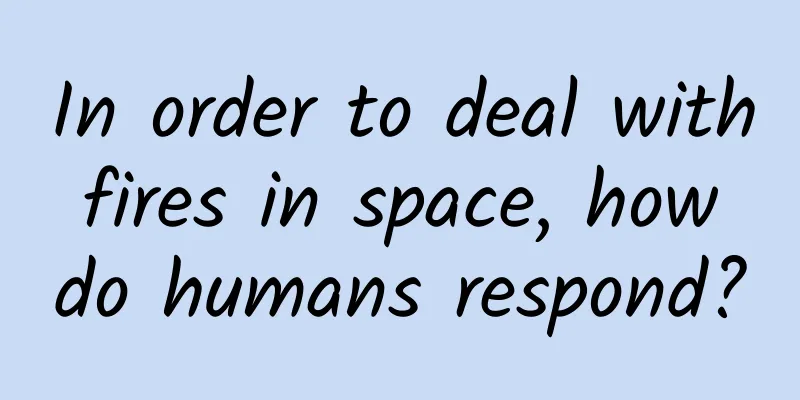In order to deal with fires in space, how do humans respond?

|
The control and use of fire is a great event for mankind. By using the power of fire, mankind invented matches, trains, fire wheels, gunpowder, as well as rockets and spacecraft, which helped them to leave the earth and enter space. It can be said that fire is the engine and booster on the road of human evolution, development and civilization. But fire is always unruly. It is like a double-edged sword, which benefits humans as well as harms them. Every time it shows its power, humans have to try to get something out of the fire, or even burn themselves. As a result, humans call it "fire". In order to increase the public's awareness of fire safety, my country has designated November 9th of each year as National Fire Protection Day since 1992. 1+3=0 In 1972, the Moscow Film Studio of the Soviet Union produced a color biographical film called "The Taming of Fire". While praising the legendary life of Korolev, the chief designer of the aerospace industry, it also told people that the development of aerospace technology is a tortuous and difficult history of taming fire. As early as the early days of the space age, aerospace experts were clearly aware that this was a high-risk industry. When manned space activities began, their awareness of risks became even stronger, because there are too many unknown areas and technologies in space flight, and even if a detail is not realized or neglected, the result may be catastrophic. This worry became a reality within a few years. In March 1961, Bondarenko, a second lieutenant of the Soviet Air Force and one of the first astronauts, died during a ground training due to a fire in the high-pressure pure oxygen chamber caused by an alcohol cotton ball. In January 1967, a fire broke out in the Apollo 1 manned spacecraft being tested on the launch pad in the United States, killing all three astronauts. Soviet cosmonaut Bondarenko died in a ground training fire The three astronauts who died in the Apollo 1 spacecraft fire (from left: Gus Grissom, Edward White, Roger Chaffee) Two fires, four deaths. Experts associate this with the difficult situation and serious consequences of a fire on a spacecraft in orbit. When a fire occurs on Earth, we can take various effective measures to put it out, and call the 119 fire alarm number, and then the fire truck will rush to put out the fire. But there is no such good show in space. You can't dial 119 there, and the fire truck is even more out of reach and can't drive there, so the astronauts are completely isolated and helpless. After a fire on Earth, people can immediately escape from the fire; but not in space. Before the advent of large manned spacecraft such as space shuttles and space stations, manned spacecraft are small and closed environments, and astronauts have nowhere to escape. Interior of the Apollo 1 spacecraft after the fire Fires in space are not groundless worries. In 1997, a fire broke out in the Russian Mir space station due to a malfunction of an oxygen generator, filling the station with choking smoke. Fortunately, the fire was extinguished after more than ten minutes and no major disaster occurred. Fires have also occurred many times on the US space shuttle. Fortunately, in the 60 years of manned space activities so far, there have been few fires, fire hazards, and fire alarms in space, and there has been no record of major fire accidents. This gratifying situation should be attributed to the solid and effective space fire safety over the years. Before the launch of the Soyuz TMA-4 spacecraft, fire trucks escorted the rocket Preventing problems before they start "Prevention first, prevention and control combined" is China's fire safety work policy. The ideas and practices of space fire safety in countries around the world are basically the same. Manned spacecraft is the crystallization of high technology. Various circuits, gas circuits, and liquid circuits are crisscrossed inside, and combustibles and flammables can be seen everywhere. Therefore, the three conditions for fire - combustibles, combustion-supporting materials, and ignition sources - are all available. To avoid fires in such dangerous environments, the best way is to focus on prevention. Specifically, it means starting from the ground, preventing fire hazards from the source, and fundamentally eliminating fire hazards and killing them in the bud. First, efforts should be made to reduce combustibles, oxidants, and ignition sources during the design of the spacecraft. In order to reduce combustibles, flame-retardant or non-combustible materials should be strictly selected when selecting heat insulation, insulation, sealing and decoration materials, otherwise they will help the fire. This is a bloody lesson from the Apollo 4A spacecraft. The fire was caused by electric sparks igniting the Raschel material mesh bag. The main fuel for fire is oxygen in the cabin, which is the lifeblood of astronauts, so it must be used scientifically. The Apollo manned spacecraft used 100% pure oxygen, but it only added fuel to the fire in the Apollo 4A fire. Only after the accident did they switch to a mixture of oxygen and nitrogen. The main source of fire ignition comes from the large number of electrical equipment on the spacecraft. Short circuits, overloads, overheating caused by poor contact and other faults may cause fires. In this regard, the "Apollo 4A" fire also provided a painful lesson. There was a metal hatch in the spacecraft's environmental control equipment compartment. When the astronauts opened the hatch, the sharp edge of the door scraped the insulation layer of the cables laid underneath, causing a short circuit and ignition. Therefore, the electrical equipment of the spacecraft must be safe and reliable to avoid forming a source of ignition. Secondly, during the production, testing and assembly of the spacecraft, strict quality control of all components is carried out to ensure the high quality and reliability of the products and to prevent leakage of various circuits, gas and liquid lines, as well as leakage of propellant. Spacecraft + Fire Extinguisher Although various preventive measures have been taken in line with the principle of "prevention first", the possibility of fire still exists, so "combining prevention and firefighting" is essential. Over the years, in order to extinguish space fires quickly and efficiently, aerospace experts and fire experts have conducted a large number of experiments, analyses and studies on the occurrence and spread of fires in microgravity, in view of the special situation that the environment of manned spacecraft is completely different from that of the earth. The results show that the burning phenomenon of fire in space is not the same as that on earth. On earth, the flame is cone-shaped; in space, it is approximately spherical due to the effect of microgravity. In addition, there are more smoldering phenomena, the combustion is confined to a smaller area, and the diffusion and propagation speed is slower. These situations show that the microgravity environment has a certain inhibitory effect on the occurrence and spread of fires, which is helpful for the implementation of firefighting work, and at the same time provides a theoretical basis for the prevention, detection and fighting of space fires. Astronauts practice using a fire extinguisher in a weightless environment aboard a KC-135 aircraft Just as early detection of human diseases is of great significance to saving lives, early detection of fire is crucial to quickly extinguishing it. Therefore, most manned spacecraft are equipped with fire alarm systems including smoke detectors to closely monitor the safety status of various parts and systems. Once a fire occurs, the alarm will immediately sound an alarm and display the specific location. Astronauts and ground control centers will take emergency measures immediately after receiving the alarm. The installation locations of these alarms are somewhat different from those on Earth. On Earth, smoke from a fire spreads upward and finally accumulates under the roof, so the alarms are mostly installed in the middle of the ceiling. In spacecraft in space, smoke does not spread upward but spreads all around, so the alarms must be installed on the ceiling as well as on other places such as the wall. It is worth noting that these highly sensitive alarms can sometimes go wrong. In September 1985, three Soviet astronauts who had just entered the Salyut 7 space station were busy checking and testing instruments when the alarm suddenly sounded. In March 2001, on the second day of the second batch of three astronauts working on the International Space Station, a fire broke out in the Destiny science laboratory module. These two fires gave the astronauts a false alarm. It turned out that there was no sign of fire in the station. The alarm was a false alarm because the dust and suspended particles in the station triggered the alarm. In addition to the fire alarm system, manned spacecraft are also equipped with fire-fighting equipment such as gas masks, oxygen cylinders, and fire extinguishers. Astronauts John Young (left) and Robert Crippen on the first test flight of the space shuttle Columbia in April 1981 Fire extinguishers are the most common firefighting equipment on Earth, except for fire trucks. They are filled with fire extinguishing agents such as water, foam, dry powder, carbon dioxide, and halogenated hydrocarbons. Similarly, fire extinguishers are also the most convenient and easy-to-use firefighting weapons in space. However, it is very picky about the requirements for fire extinguishing agents. After all, the environment for extinguishing fires in space is different from that on Earth. For example, water, which is the most commonly used fire extinguishing on Earth, is generally not used in space, because after the water is sprayed out, it is difficult to concentrate on the flame under microgravity conditions. It will only form water droplets and mist floating around in the cabin. Once it penetrates into the instruments and equipment, it may cause a short circuit. Dry powder fire extinguishers are even less applicable because the pollution caused is too serious. When using it to extinguish a fire, the instruments and equipment will not short-circuit, but can the cockpit still be used? Foam fire extinguishers were once equipped on the command module and sky laboratory of the Apollo spacecraft, but there has never been an opportunity to extinguish a fire, otherwise the pollution generated would not be small. Astronauts of the Space Shuttle STS-114 crew are learning how to use a fire extinguisher In contrast, carbon dioxide fire extinguishers are more effective in extinguishing fires on spacecraft, which are filled with precision instruments. They are very clean after extinguishing the fire, leaving no trace of pollution. However, when the concentration of carbon dioxide in the air reaches a certain level, it will endanger human life. Perhaps, when the fire is extinguished, the astronauts are also "extinguished". Halon was once a fire extinguishing agent with good performance. The Halon 1301 fire extinguisher equipped on the US space shuttle belongs to this type. It has a good fire extinguishing effect and leaves no traces after the fire. It was once widely used in the world. However, although it is non-toxic and harmless to the human body, it has a destructive effect on the atmospheric ozone layer and has been no longer produced and used for many years. At present, scientists are still researching and testing fire extinguishing agents that are suitable for various fires, which are both high-energy and efficient, and non-toxic and pollution-free. Some have achieved significant results, such as fine water mist fire extinguishing technology. It uses pump pressure or air pressure to spray water to form mist-like water droplets, which have a cooling and suffocating effect on the flames. It can effectively extinguish various fires in space. Since the fire extinguishing agent used is ordinary water, this fire extinguishing technology will not cause harm to personnel and equipment. In other words, when the fine water mist technology matures and is officially applied, water that was previously unsuitable can also be used to extinguish fires in space. Testing of portable water mist fire extinguishers No matter what kind of fire extinguisher or fire-fighting equipment, it must be guaranteed to be in good condition and available at any time. We cannot wait until the fire breaks out like the Mir space station, where we find that some oxygen masks are broken and some fire extinguishers cannot be removed, thus wasting the opportunity to put out the fire. Astronaut = Firefighter There is a saying that "fire and water are merciless". Once a fire occurs in space, the instruments and equipment on the manned spacecraft may be destroyed. A major fire will also endanger the safety of the spacecraft, as well as the health and lives of astronauts. Therefore, when a fire occurs, the fire alarm is an order, the fire scene is a battlefield, the spacecraft is a fire truck, and the astronauts are firefighters. Japanese astronaut Akihiko Hoshide checks a portable fire extinguisher on the International Space Station In critical moments, astronauts will step forward, but they must remain calm and avoid panic. Only in this way can they make an accurate judgment of the fire situation. In fact, this is not difficult for astronauts with good psychological qualities. The difficulty is that firefighting in space is much more difficult than on Earth. For example, it is very simple to use a fire extinguisher on Earth. First, pull out the safety pin, then aim the nozzle at the flame and press the handle. However, in space, you may fly far back as soon as you press the handle because the sprayed fire extinguishing agent will produce a reaction force. Therefore, astronauts must carefully learn the compulsory course of space firefighting before space flight, including strict firefighting training. Before extinguishing a fire, astronauts must first do a good job of personal protection, including wearing gas masks or oxygen cylinders, because flames and smoke contain a variety of toxic gases that endanger human health and even life. Only after ensuring safety can they implement firefighting according to emergency plans and specific circumstances. European astronaut Frank Devine performs his monthly check of his portable respirator aboard the International Space Station Fire extinguishing methods can refer to the isolation, suffocation, cooling and suppression methods on Earth. According to the isolation method, the valves of the flammable gas and liquid pipelines should be closed, and the flammable materials near the fire source should be moved away. According to the suffocation method, the ventilation system should be cut off as soon as possible to prevent the formation of air convection and provide the required air for combustion; the burning materials can be covered with non-combustible or flame-retardant materials to prevent air from entering the combustion area. The most effective suffocation method is emergency cabin decompression, which is to release the air in the spacecraft, to remove the fire from the bottom of the pot, so that it will extinguish itself due to lack of air, and finally restore normal cabin pressure. The Gemini, Apollo, and space shuttles of the United States, the Soyuz manned spacecraft of Russia, and the International Space Station all have this decompression function. When the fire cannot be extinguished after all methods have been exhausted, cabin decompression will become a killer weapon for space fire extinguishing, provided that special space suits and other protective equipment are strictly worn. The other two methods of fire extinguishing - cooling method and suppression method are to spray fire extinguishing agents on the burning materials. The former is to reduce the temperature of the burning materials to below the ignition point, and the latter is to stop the combustion by suppressing the chemical reaction process of combustion. When all methods have been exhausted and the fire cannot be controlled, the astronauts cannot sit and wait for death. They can abandon the ship (station) and escape. Both the Mir Space Station and the International Space Station have rescue spacecraft, which the astronauts can use to evacuate urgently and return to Earth. Of course, this is a result that no one wants to see. The development of manned space technology requires the development of firefighting technology. Perhaps one day in the future, when manned spacecraft are as numerous as buildings on Earth, space "fire trucks" will run among them, with sirens blaring as they drive towards burning spacecraft. Needless to say, the 119 fire alarm telephone in space must have been opened by then. |
Recommend
Summary of iOS classic interview questions - memory management
[[163414]] I made a summary based on my own situa...
Mini programs are so popular, why don’t you learn JS?
Although a week has passed since WeChat officiall...
The official released "Top Ten Medication Tips for the Public". Are you aware of these medication misunderstandings?
“What is a chronic disease? What are its characte...
This highly poisonous plant feeds at least 800 million people. You must have eaten it.
A 17th-century natural history painting of cassav...
SEM bidding hosting service content
The content of SEM bidding hosting provided by Ku...
Is there any scientific basis for the idea that hiccups can be cured by being startled?
Reviewer of this article: Chen Haixu, Deputy Dire...
How can we get a reliable cancer screening that can cost thousands of dollars?
At the end of each year, many institutions organi...
China Customs: China's semiconductor manufacturing equipment imports in Q3 2023 soared 93% to RMB 63.4 billion compared with the same period last year
According to recent news, although the United Sta...
You can make money by posting pictures on Tik Tok! The practical document is worth 1,299 yuan and is full of useful information!
You can make money by posting pictures on Tik Tok...
Look at the product growth of WeChat Reading through the AARRR growth model!
As we enter the second half of the mobile Interne...
Pear Diet: Why does a website's homepage ranking depend on what users want?
It is no use having a good website that just look...
"Iris photography" suddenly became popular! Is it safe? Doctors warn...
Recently, a new type of "iris photo" ha...
Can the Wenchang Tower be placed in the living room? It is best to place it in Wenchang position
In ancient times, there was a star called Wenchan...
Apple releases iOS 9.0.1, fixes multiple bugs
Today, Apple released iOS 9.0.1, a minor update t...









